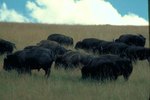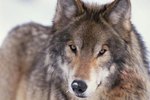
Per square mile, the Democratic Republic of Congo is the most resource-rich country in the world, containing two-thirds of the world’s remaining rain forests. Sadly, years of armed conflict, rapid deforestation, overhunting and the illegal bushmeat and exotic wildlife trade have had a devastating effect on many animal species in this war-torn country. Mammals, birds, amphibians, fishes and arthropods are among the 51 species on the 2013 IUCN Red List of endangered animals.
Threats to Native Mammals
Habitat destruction and fragmentation, deforestation, human intrusion from mining and agricultural operations, and, formerly, commercial whaling, threaten the mammals of DR Congo. Nine terrestrial species and two marine species are already endangered. In addition, pressure by locals, who heavily depend on the forest and its animals for their entire subsistence, has played a major role in the decline of wildlife. The people of DR Congo are among the poorest in the world. Ravaged by war, with few other economic opportunities, they have turned to the illegal trade of bushmeat for clothing, medicines, soap, spices and other necessities. They also consume bushmeat as their primary source of protein and contribute to deforestation by relying solely on the forests for fuelwood, charcoal and other raw materials. The illegal exotic wildlife trade also contributes to the decline in primate populations.
Endangered Primates

Endangered primates in DR Congo are: the endemic bonobo (Pan paniscus), also known as the pygmy chimpanzee, the common chimpanzee (Pan troglodytes), and the eastern gorilla (Gorilla gorilla), consisting of two sub-species -- the mountain gorilla (Gorilla beringei beringei), of which only 800 individuals remain in their natural habitat, and the Grauer’s gorilla (Gorilla beringei graueri), also called the eastern lowlands gorilla. Victims of the illegal bushmeat trade, and in the case of chimpanzees,the exotic pet trade, the animals known as the "great apes" are perilously close to extinction.
The African Wild Dog
In the case of the endangered African wild dog (Lycaon pictus), also known as the painted hunting dog or cape hunting dog, a number of factors have contributed to their rapidly declining numbers; more than half of all adult deaths are due to human activity. Ranging outside their protected areas, they encounter high-speed vehicles, guns, snares and poisons. Encounters with domestic dogs also represent potentially lethal diseases, such as rabies and canine distemper. Initiatives to save African wild dogs include conservancies on private and communal land which protect them from people and domestic dogs, as well as education programs to reduce the deliberate killing of the dogs by the locals in and around protected areas.
Endangered Shrews and Rats
Some species of shrews and rats are dwindling, their declining populations indicative of the devastating effects of deforestation in the DR Congo. The following species are endangered: the Kivu long-haired shrew (Crocidura lanosa), the Montane mouse shrew (Myosorex blarina), the Tarella shrew (crocidura tarella), the narrow-headed shrew (Crocidura stenoceph) and the Rahm’s brush-furred rat (Lophuromys rahmi).
Endangered Whales
Marine mammals, the fin whale (Balaenoptera physalus) and the sei whale (Balaenoptera borealis) are on the IUCN endangered list, however, their endangered status is reversible and numbers are increasing due to the cessation of commercial whaling. Native to DR Congo their populations were decimated by nearly 70 percent over the last three generations.
Endangered Birds
Major threats for 14 species of endangered birds in the DR Congo are pollution, and habitat degradation and fragmentation, from mining and farming operations, resulting in a loss of foraging range and reduced availability of food. For vultures, the poisoning of carcasses has also taken a toll on their populations who congregate in large numbers to feed on carrion. Other contributing factors in their decline is the trade in live specimens, and electrocution and collision with power lines. Endangered vultures are the white-backed vulture (Gyps africanus), the Rueppell’s vulture (Gyps rueppellii), the Egyptian vulture (Neophron percnopterus) and the hooded vulture (Necrosyrtes monachus). Other endangered birds are the Congo bay owl (Phodilus prigoginei), the golden-naped weaver (Ploceus aureonucha), the Grauer’s swamp warbler (Bradypterus graueri), the gray-crowned crane (Balearica regulorum), the Madagascar pond heron (Ardeola idae), the Itombwe nightjar (Caprimulgus prigoginei), the Nahan’s francolin (Francolinus nahani), the Prigogine’s greenbue (Chlorocichia prigoginei), the spotted ground thrush (Zoothera guttata)and the Turner’s erommomeia (Eremomela turneri).
Endangered Amphibians
Three amphibian species are endangered in the DR Congo; the Hyperolius leleupi, the Hyperolius leucotaenius and the Leptopelis karissimbensis. The major threat is likely to be habitat loss for agriculture, livestock and human settlements. As well, political instability continues to threaten the remaining habitat in their range.
Endangered Fishes
Native freshwater and oceanic fish in the DR Congo are threatened with exploitation from continued intensive unregulated fishing, agricultural chemicals, toxic plants used for fishing, small-mesh-size nets in which they are caught as the “bycatch” of other species' fishing, pollution and habitat modification through erosion and urbanization. The 21 endangered fish species, listed by their common names where applicable, are the albert lates (Lates macrophthalmus), the Alestopetersius nigropterus, the Amphilus lamani, the Dasyatis margarita, the dusky grouper (Epinephelus marginatus), the forktail lates (Lates microlepis), the Hemichromis cerasogaster, the hummingbird lampeye (Poropanchax myersi), the Lamprologus tumbanus, the Lubbert’s guitarfish (Rhynchobatus luebberti), the Mai-ndombe dwarf sprat (Nannothrissa stewarti), the Nanochromis transvesititus, the Synodontis dorsomaculatus, the Tanganyika lates (Lates angustifrons), the Tylochromis microdon, the pincushion ray (Urogymnus ukpam), the Nothobranchius polli, the Nothobranchius resenstocki, the Nothobranchius symoensi, the Oreochromis lepidurus and the Victoria robber (Brycinus jacksonii).
Endangered Arthropods
Endangered arthropods in the DR Congo are two crustaceans, Potamonautes gonocristatus and Potamonautes idjiwiensis. Both endemic to the DR Congo, they have only been known to scientists for 55 and 60 years respectively. Now found mostly in museum collections, only a few thousand exist in their natural freshwater habitat of streams, in and around the Lake Kivu area.
References
- Virunga National Park, Gorilla.CD: Protecting Virunga
- Endangered Species International: Stop the Bushmeat Trade
- World Wildlife Federation: Congo Basin
- Heal Africa: History of the Congo
- Endangered Species International: Bushmeat Crisis
- Endangered Species International: Bonobos
- Steppes Discovery: Forest Elephants
- Earth's Endangered Creatures: Endangered Animals of Africa
- International Union of Conservation of Nature and Natural Resources: Red List: African Wild Dog
- International Union for Conservation of Nature and Natural Resources: Red List: Bonobo
Resources
- USA Today: Congo Civil War
- Virunga National Park: First Gorillas Found in Rebel-Held Territory
- Steppes Discovery: Forest Elephant and Lowland Gorillas in the Congolese Rainforest
- International Union for Conservation of Nature and Natural Resources: Red List: Gorilla Beringei (Eastern Gorilla)
- International Union for Conservation of Nature and Natural Resources: Red List: Chimpanzee
- International Union for Conservation of Nature and Natural Resources: Red List: Fin Whale
- National Primate Research Center, University of Wisconsin : Bonobo
- International Union for Conservation of Nature and Natural Resources: Red List: Pond Heron
- International Union for Conservation of Nature and Natural Resources: Red List: Grey-Crowned Crane
- International Union for Convservation of Nature and Natural Resources: Red List: Grauer's Swamp Warbler
Photo Credits
-
Anup Shah/Digital Vision/Getty Images
Writer Bio
Based in Ontario, Susan Dorling has written professionally since 2000, with hundreds of articles published in a variety of popular online venues. Writing on a diverse range of topics, she reflects her passion for business, interior design, home decorating, style, fashion and pets.




